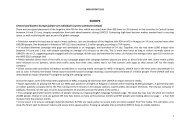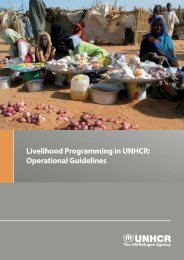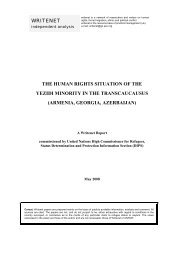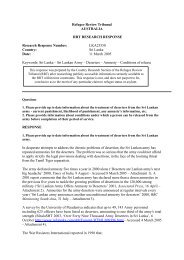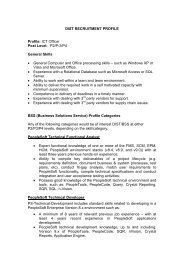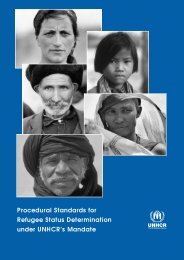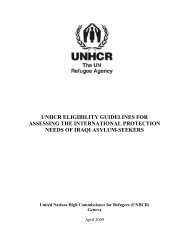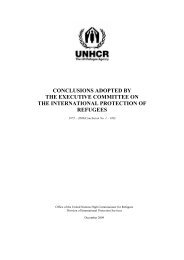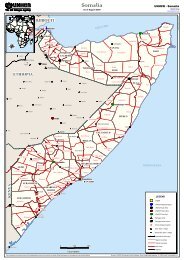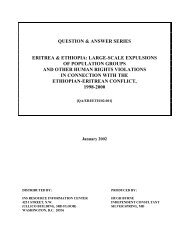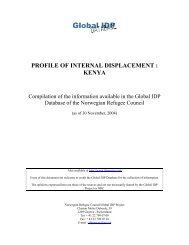UNHCR's ELIGIBILITY GUIDELINES FOR ASSESSING THE ...
UNHCR's ELIGIBILITY GUIDELINES FOR ASSESSING THE ...
UNHCR's ELIGIBILITY GUIDELINES FOR ASSESSING THE ...
You also want an ePaper? Increase the reach of your titles
YUMPU automatically turns print PDFs into web optimized ePapers that Google loves.
There are a number of possible motives behind attacks on journalists and media workers.<br />
The ongoing sectarianism has increasingly politicized the media sector in Iraq and most<br />
media outlets are affiliated with a sectarian or political bloc. Journalists fall victim to<br />
revenge killings, in particular when they become involved in controversial political issues<br />
or describe corruption or human rights violations committed by certain persons or groups.<br />
Sectarian violence also took its toll on journalists, with gunmen targeting journalists whom<br />
they accuse of siding with either Sunnis or Shi’ites. 582 For example, on 18 September 2006,<br />
Ahmed Riyadh Al-Karbouli, a correspondent for Baghdad TV, which is owned by the Iraqi<br />
Islamic Party, was shot by gunmen in Ramadi. Al-Karbouli worked at Baghdad TV for two<br />
years covering security and the situation of the residents of Ramadi. According to CPJ<br />
sources, “his reports offended some insurgents in Ramadi who felt he was criticizing them.”<br />
One month before the killing, gunmen had stormed into his house and threatened him in<br />
front of his family. 583<br />
The most deadly attack on members of the Iraqi media took place on 12 October 2006,<br />
when gunmen wearing police uniforms stormed the offices of Al-Shabbiya, a new satellite<br />
television station in Baghdad. Eleven employees, including its founder and director, Abdul<br />
Rahim Nasralla Al-Shameri, were killed. The identity and motive of the killers were not<br />
known, but Shi’ite militias or police units are suspected to have carried out the attack for<br />
sectarian reasons. 584 The channel had only transmitted some test broadcasts of patriotic<br />
music and videos as it was to officially start two days later. Reportedly, it was aimed at<br />
a mainly Sunni audience. 585 In another example, journalist Fadia Mohamed Ali and her<br />
driver were killed on her way to work. According to UNAMI HRO, there are strong<br />
indications that she was targeted by elements of the Iraqi Police as she had repeatedly<br />
written about police corruption and misconduct during raids. 586<br />
Journalists have also been targeted for “collaborating” with the MNF or the “West”, in<br />
particular when they work for foreign (especially English-speaking) media outlets. 587 For<br />
example, it was reported that journalists in Mosul received threatening letters accusing<br />
582<br />
RSF, Iraq – Annual Report 2007, see above footnote 580; see also IRIN, Iraq: Fighting swords with pens,<br />
27 November 2006, http://www.irinnews.org/report.aspx?reportid=61967; Kirk Semple and Qais Mizher,<br />
Gunmen Kill 11 Employees of a Satellite Television Station in Baghdad, The New York Times, 13 October<br />
2006, http://www.nytimes.com/2006/10/13/world/middleeast/13iraq.html; BBC News, Gunmen kill eight in<br />
Iraq TV raid, 12 October 2006, http://news.bbc.co.uk/2/hi/middle_east/6043158.stm; Firas Al-Atraqchi, Iraqi<br />
journalists stare death in the face, Al Jazeera, 9 October 2006, http://english.aljazeera.net/NR/exeres/<br />
9175100C-8FD3-4D90-9068-EF2361935EF3.htm. See also “Shi’ites and Sunnis Civilians”.<br />
583<br />
CPJ, IRAQ: TV correspondent murdered in Ramadi, 18 September 2006, http://www.cpj.org/news/2006/<br />
mideast/iraq18sept06na.html.<br />
584<br />
Semple and Mizher, see above footnote 582; BBC News, Gunmen kill eight in Iraq TV raid, 12 October<br />
2006, http://news.bbc.co.uk/2/hi/middle_east/6043158.stm.<br />
585<br />
Ibid.<br />
586<br />
UNAMI HRO, December 2006 Human Rights Report, p. 14, see above footnote 10.<br />
587<br />
RSF, Iraq – Annual Report 2007, see above footnote 580; IRIN, Iraq: Fighting swords with pens, see<br />
above footnote 582. See also “Actual or Perceived Sympathizers of the US-Led Invasion and/or the Multi-<br />
National Force in Iraq”.<br />
113




